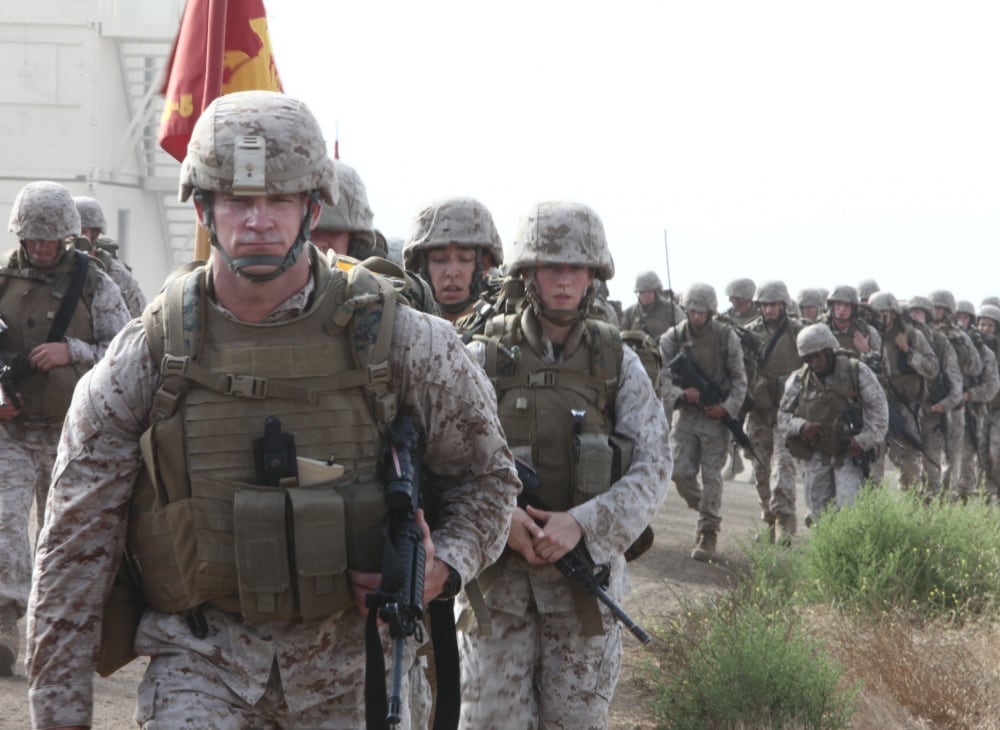The Corps will no longer field a force focused on capturing a contested area, but rather one designed to survive deep inside a contested zone while supporting a Naval campaign.
The focus was announced in the new Tentative Manual for Expeditionary Advance Base Operations Manual released by the Marine Corps in February.
The 184-page tentative manual is meant to give Marines an idea of the future operating concept while the Corps continues develop the strategy.
As the Corps transforms over the next decade the traditional infantry-focused, land-capturing mission of the Marine Corps may be de-emphasized, but the “warrior mindset” of Marines must remain, the manual said.
“A littoral force is only relevant if it maintains the ability to apply force at the time necessary to generate options and influence the greater campaign,” the manual said. “Operating in a distributed environment with limited support and resources will require a force with the warrior mindset, as well as the mental agility to rapidly shift perspectives and generate alternatives.”
RELATED

The tentative manual’s release is the latest of several steps the Corps has taken as it prepares to faceoff against China in the littorals of the South China Sea and moves away from the force that has spent the majority of the past two decades fighting insurgents in the Middle East.
Against China, Marines would be forced to operate well within range of long-range missiles that could potentially knockout large formations in a single blow.
“The impending challenge is significant and cannot be met by merely refining current methods and capabilities,” the manual reads.
Marines will operate from expeditionary advanced bases dotted around the islands and atolls within the littorals of any future conflict.
Having Marines spread out will provide a strong force capable of fighting immediately, while holding open key sea lanes.
The dispersion of the bases, along with the Marine Corps’ ability to move forces around different littorals quickly and quietly, will make it hard for the enemy to land a decisive blow against the Marines, while the beefed-up firepower of these small units will make them too strong for any enemy to ignore.
A “littoral force” may head to the battle with the capabilities to complete all of these missions only to be given its specific task right before entering the fight.
The flexibility of the force will make it harder for any potential enemy to plan for and counter Marines.
The Corps has started experiments with what a littoral force will look like standing up the first Marine littoral regiment in Hawaii.
The littoral regiment will be made up of roughly 2,000 Marines and contain three elements- the littoral combat team, the littoral anti-air battalion and the littoral logistics battalion.
In addition to providing a little more detail on how the Marine littoral regiment will be organized, the manual lays out the organization of the 2030 Marine Expeditionary Unit.
Future MEUs will be capable of “operating both from the sea and expeditionary advanced bases,” the report said.
“It will be capable of enabling sea denial and conducting amphibious operations, crisis-response operations, and designated special operations to support the requirements of multiple combatant commanders,” it added.
In 2030 each MEU will look a little different depending on where it is deploying to and the expected missions it will take on. The only constant will be the command element, the manual said.
The change in force design has been championed by current Marine Corps Commandant Gen. David Berger since he took over as the top Devil Dog in 2019.
The plan will see the Marine Corps get smaller and lighter, shedding certain capabilities like its tanks, while focusing on investments into long-range missile fires, drones and cyber warfare.
Berger hopes the Marine Corps will complete its transformation by 2030.
“The threats we face morph daily, and so this is an initial concept that will only turn into doctrine when we are satisfied that it best blends a fixed body of experiments and data with the flexibility to outpace the threat,” Lt. Gen. Eric Smith, deputy commandant for Combat Development and Integration, said in an email.





